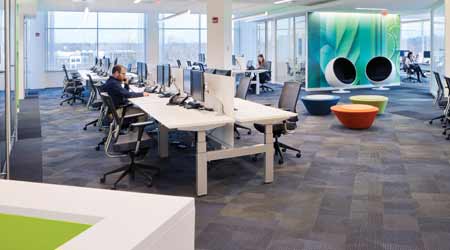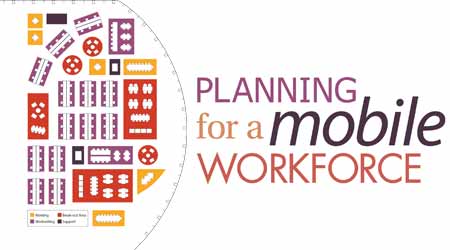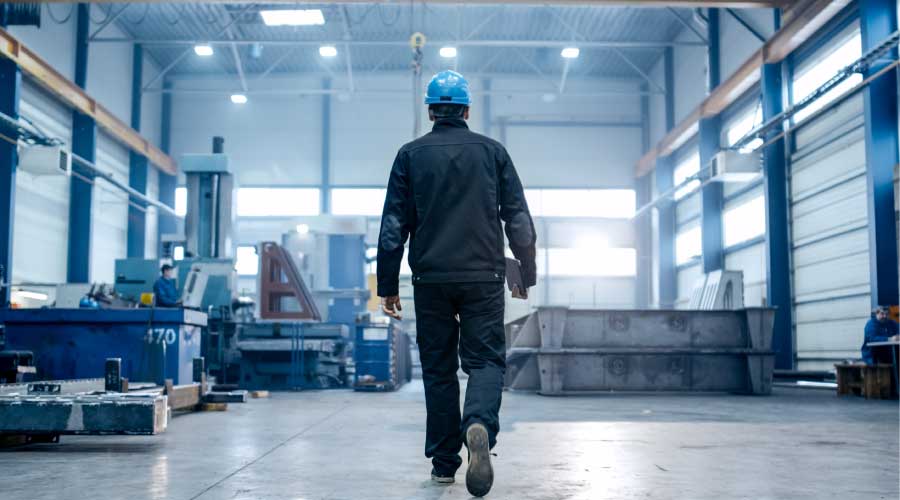FMs Should Consider Two Common Mobile Workplace Methodologies
Second of a three-part cover story article exploring how FMs can adapt their workplaces to an increasingly mobile workforce.
There are two common workplace methodologies for designing a mobile workplace: immersive and connected. While there are similarities, each concept is distinctly different.
The “immersive approach” is designed to support a business model where space is defined within every department to accommodate remote workers. These spaces are designed to be similar to the company’s standard work setting but are scaled down in size to reflect a shorter stay requirement. The idea behind an immersive plan is to place visiting remote staff where they can socially connect with peers when they are in the office, promoting a higher degree of communication and collaboration among teams. Boston-based Iron Mountain, a provider of storage and information management solutions, adopted this approach to enable its mobile workforce to feel integrated with colleagues when in the office. Businesses whose mobile work strategy is driven by unexpected staff growth often deploy this planning model as it is simpler and less expensive to achieve.
When a company introduces a “connected work” program, it is often a response to having a much higher percentage of remote workers. This approach typically reflects an activity-based design model and does not assign traditional work settings for remote workers. The anticipation is that remote workers, when at the workplace, will identify their own space needs based upon the work that they will be accomplishing during their time in the office. For example, if an employee is in the workplace specifically to meet with co-workers, for training, or to work on a special equipment-oriented task, that person may not necessarily need or want a traditional office or workstation to accomplish those tasks.
Philips North America, a health and well-being company focused on healthcare, consumer lifestyle, and lighting, chose the connected work approach when it introduced its workplace innovation model in its Andover, Mass., office. In adopting a completely address-free design strategy, the company empowered employees to decide what type of space was most efficient and desirable for their specific needs. In most cases, a connected work strategy is supported by base staff and technology that enables the reservation of space ahead of time.

(Philips North America adopted a completely free address design to enable employees to choose space based on workflow, projects, and access to other employees in the office. Credit: Warren Patterson Photography)
Companies with a workforce that is geographically disconnected often develop leasing relationships with shared, co-working spaces such as WeWork, Workbar, and Regus. These facilities provide functionally versatile work environments for remote workers who, when necessary, require more advanced business tools or meeting space than they have in their homes. As the percentage of mobile workers increases, the demand for these types of satellite support spaces has grown exponentially. WeWork alone has 23,000 customers and more than 32 separate locations occupying more than five million square feet. These co-working spaces often engage in a sublease profit-sharing agreement with landlords, which increases their desirability as a tenant.
For the company that chooses to adapt its own work environment to accommodate a mobile workforce, there are several key factors to consider:
1. Preservation of culture. Every business has a certain ethos that is unique to who it is and what makes it succeed. It is critically important that any change to a work environment supports the company’s brand and philosophy. Change of any kind is difficult, and environmental change can be disruptive — or transformative. A well thought out design execution for mobile work space should integrate elements of the business culture through careful consideration of location, branding, and adjacencies to common social spaces.
2. Technology. For a mobile work space to succeed, it must support the way people work, and technology plays a critical role in this effort. At a minimum, a work environment should provide a strong Wi-Fi signal that allows all workers to access the business network wherever they are within the office. Additionally, a successful design should ensure that each workspace be equipped with an easy-to-use digital display. The proper placement of accessible computers and AV-ready conferencing technology will enable both individual and collaborative activity. Not to be neglected is the importance of digital security. Companies with expanded ease of digital access must find the appropriate balance between protection of intellectual property and convenience of use for its employees.
3. Meeting space. Mobile workers, who are not regularly connected to their colleagues, will inevitably want to spend a larger portion of their in-office time reconnecting face-to-face with their peers. To accommodate that, a workspace should support a larger percentage of various sized meeting spaces. While enclosure is optimal for most meetings, it should be noted that not all meetings are of a highly confidential nature. Common spaces, huddle areas, lounges, and dining areas can also serve this function handily if meeting technology is readily accessible.
4. Quiet space. Working in a space that reflects a high degree of interaction or collaboration may support a team-based work style, but it will not provide the necessary environment for task-intensive, concentrative work. A work environment should serve a variety of tasks and work style needs, so small work rooms or “library” spaces should be designated for quiet, heads-down work.
5. Power and connectivity. Mobile workers will enter the work environment with a host of devices such as laptops, tablets, and phones. These tools are essential to the way they perform their work. Unfortunately, most offices are not designed to support charging all these battery-powered devices at once. In order for the space to become truly functional, careful thought should be given to providing multiple charging stations at convenient locations throughout the office.
Mobile work environments, whether designed initially or adapted after the fact, can be highly productive space as long as they are specifically planned to accommodate the unique needs of the staff who will use them. Thoughtful advance utilization analysis and design execution will yield a successful result.
Joe Flynn, CFM, LEED AP, is a senior associate and workplace strategist at Margulies Perruzzi Architects. He can be reached at jflynn@mp-architects.com. The firm services the healthcare, corporate, professional services, research and development, and real estate communities.
Email comments to edward.sullivan@tradepress.com.
Related Topics:















